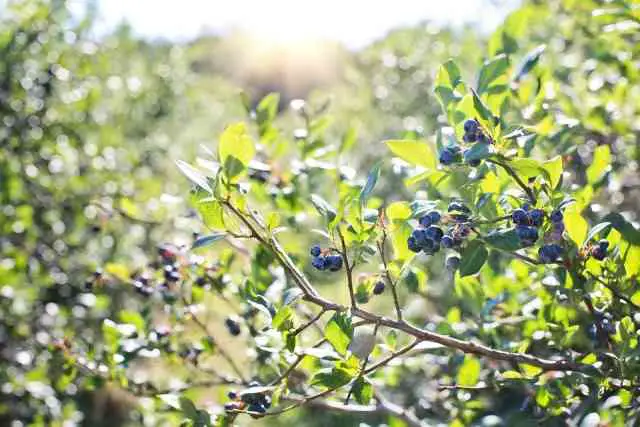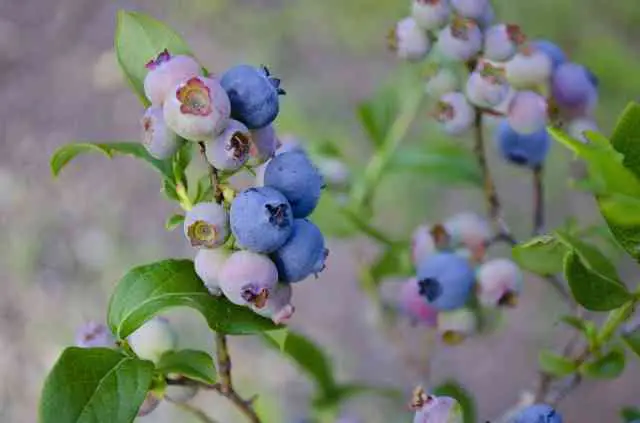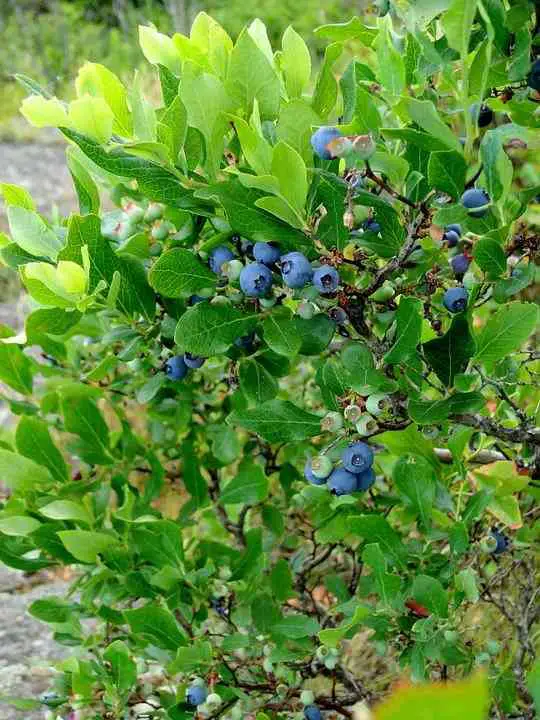Blueberries are just as nutritious as they are delicious. Fresh, homegrown blueberries are even healthier and tastier – not to mention the satisfaction of picking and eating right off the bush! Well-maintained blueberry bushes can be productive for 40 to 50 years. If you know how to care for blueberry bushes, you can enjoy a hefty supply of plump blueberries each season.
Besides the consistent supply of fresh berries, a blueberry bush is a beautiful addition to your landscape. They don’t pose many pest problems and will easily grow in most zones in the continental US. Since there are so many different varieties, it’s easy to find a cultivar well-adapted to the growing zone to enjoy the best results.
Reader Poll: What online courses would interest you?
Varieties of Blueberries
Blueberries produce best when they are cross-pollinated. This means that you should ideally plant at least two bushes of different varieties for a higher and better yield. Blueberry cultivars fall into four basic categories, each of which is suited to different climates. Select varieties that are well suited to your growing zone:
Lowbush
Lowbush blueberries are the types best suited for colder climates. These are hardy to zones 3 to 7 and grow to only a foot tall, as the name suggests. Native to Canada and the northeast US, these are creeping plants, great for growing as a ground cover. These are often considered as “wild” berries, without many named cultivars. You can find them in nurseries as seedlings or unnamed wild varieties.
Highbush
Highbush blueberry is the type that’s most commonly planted. It’s also the most productive among the three. It’s hardy to zones 4 to 7 and typically grows as tall as 6 feet. Highbush varieties grow best in warmer climates and will not tolerate extended periods of cold. However, if you have cold winters, some highbush blueberries like Bluecrop, Blueray, Herbert, and Jersey are good options. Berkeley, Bluecrop, Coville, Darrow are some highbush varieties that produce big berries.
Subscribe to our newsletter!
Half-High Blueberries
These are new varieties created through the cross between lowbush and highbush blueberries. Most of these are developed in Minnesota and Michigan, including Northcountry, Northblue, and Northland. They typically grow between 18 to 48 inches tall, with slightly less sweet berries than highbush varieties but present better storage properties.
Rabbiteye
Hardy to zones 7 to 9, Rabbiteye grows as high as 15 to 20 feet and is more tolerant of dry conditions than other varieties. It will easily adapt to different climates and offers a higher pest resistance as compared to other varieties. However, since they have low self-fertility, you’ll need to grow two or more varieties for adequate pollination and fruiting. Some popular Rabbiteye blueberries include Powderblue, Brightwell, Woodard, and Delite.
What Are The Requirements Of A Blueberry Bush?

Though there are several varieties of blueberries to grow, they have much the same basic requirements. It’s worth learning what the bush requires to thrive so you can maintain it well.
- Full sunlight – at least 6 hours a day
- Acidic, well-drained, organic soil
- Consistent moisture
- Pruning the bushes as needed
Maintaining The Right Soil For Blueberry
Blueberries grow best in acidic, light, organically rich soil. Since they are shallow-rooted bushes, they need soil that can retain enough moisture for the roots, but at the same time, it should also drain well. Heavy, clayey soil that takes a long time to drain isn’t good for blueberries. If you have clay soil in your garden, you should amend it several months in advance before planting blueberries to improve the structure. An easier alternative would be to grow blueberries in raised beds filled with light, well-draining soil.
Soil acidity is vital when growing blueberries. The soil pH should ideally be between 4.0 to 5.0. If the soil pH is higher than the ideal range, the bushes may experience stunted growth. To acidify the soil, mix garden sulfur in the top 6 inches of the soil several months before planting blueberries at the location. A soil test will further clarify the right amount of sulfur that needs to be added to the soil to bring the acidity to the ideal range. Peat moss, pine needles, and pine bark are also good amendments to lower soil pH.
Maintaining suitable soil for blueberries is an ongoing process. Since they can survive and produce for several years, planting in the right soil isn’t enough. You’ll need to check and amend the soil with more organic matter and sulfur (if required) periodically to make sure your blueberry bushes continue producing optimally.
Blueberry Bush – Care And Maintenance

Blueberry bushes can have a long productive life if you give them the care they expect. Well-maintained blueberry bushes will continue giving loads of sweet, juicy berries for years to come. Here are some things you need to be careful about if you want to be loaded with fresh berries each season:
Watering
Blueberries need 1 to 2 inches of water each week – probably more during hot, dry spells. Since they are shallow-rooted bushes, their roots don’t protrude deep in search of water. Instead, they’ll rely on the moisture from the top few layers. Make sure soil stays consistently moist through regular, deep watering.
Apply at least 2 inches of organic mulch on the soil around the plants to help them retain moisture. Pine needles, bark, sawdust, and woodchips are all good choices for mulching blueberry bushes.
Weed Control
Weeds will compete with your blueberry bushes for water and nutrients. Regular weeding is essential around young blueberry plants since they’ll not establish well if they face competition for water, nutrients, and space. Keep the area weed-free for a neat and healthy environment for your young blueberry bushes.
Discourage Fruiting For Young Plants
While blueberries will start blooming and fruiting from the very first year of planting, most gardeners don’t allow the bush to produce any fruit during the first two years. Instead, they pinch back any flowers that appear on the bushes in spring. This allows the plant to concentrate its energy on growth and form a well-established growth before setting fruit after the first two years. If you let the bushes fruit from the first year, plant’s growth will be stunted. What you need is a healthy, good-sized bush that can support abundant berries.
Pruning
No pruning is necessary during the first two years of planting. All you need to do is to remove the blossoms that appear during these two years. From the third year of planting, prune the bushes in early spring when the plants are still dormant.
Remove the dead, damaged, diseased canes and those that are growing too low to the ground. Also, remove the older canes that were not productive in the previous year. Remove all but 3 to 4 of the new canes that were produced in the previous season. To remove the canes, just cut them to the ground using sharp pruning shears.
Pruning your blueberry bushes once each year is very important to stimulate new growth and keep them fruiting in the following years. One-year-old healthy canes are the most productive ones. Older canes lose their productivity, so your aim should be to maintain a good supply of healthy, new canes.
Feeding
Don’t fertilize the plants during the first year of planting since young roots are weak and sensitive to salts. Ammonium sulfate is a good fertilizer for blueberries and helps in maintaining the desirable pH of the soil. Alternatively, you can choose any fertilizer suitable for acid-loving plants. Blueberry food is a good choice for feeding the bushes.
A year after planting, start applying fertilizer every 6 weeks. Just sprinkle a tablespoon of fertilizer around each plant, spreading it evenly in a 12-inch radius from the plant. Red or light green leaves in the summers are an indication that the soil pH isn’t in the optimal range, 4.0 to 5.0, and fertilizer application is needed to bring it back to the desirable range.
Protecting From Birds
Birds are as fond of blueberries as you. If you want to protect your blueberries from hungry birds, drape bird netting over your plants well in time. As soon as the first berries change color from green to blue, it’s time to string netting over the bushes. Alternatively, you can also spray the plants with sugar solution as soon as they start to ripen.
Research at Cornell University has found that spray created by dissolving 5 pounds of sugar in 2 quarts of water can significantly reduce bird damage to the berries. This is because though birds can easily digest glucose found in fruits, sucrose found in table sugar is much harder for them to digest.
Blueberry Bush Problems

Blueberry bushes are bothered by a bunch of pests and diseases. However, these problems can be kept at a minimum and are easily manageable as long as you maintain the bushes well. In general, here are some problems you need to keep a lookout for when growing blueberries.
Pests
Birds are by far the biggest problem you can encounter with blueberries. Besides birds, here are some insects that may bother your bushes:
Blueberry Maggots
Blueberry maggots are the larvae of blueberry fruit fly, Rhagoletis mendax. The adult flies lay eggs as soon as the fruits start ripening. You can identify the flies by the zig-zag black bands on the back of their white bodies. Use red sticky ball traps to capture the adult flies before they get a chance to lay eggs.
Japanese Beetles
Japanese beetles are easily identified with their shiny bodies with metallic green and copper wings. They eat away the leaves, leaving a lace-like pattern on the damaged foliage. While small infestations aren’t a problem since blueberry bushes won’t be harmed if they lose up to one-fourth of their leaves, heavy infestations need to be addressed. Japanese beetle traps and organic pesticides are good options for getting rid of these pests. You can also remove and destroy them manually from the plants.
Diseases
Blueberry bushes don’t encounter many diseases, especially if they are maintained well. Nonetheless, here are few diseases you should know about:
Anthracnose Fruit Rot
Anthracnose is a fungal disease that thrives in damp, warm weather. Symptoms include the appearance of pink spores on developing berries. Heavy infections can cause a serious drop in yield. If the disease goes unnoticed, it will cause the fruit to rot in storage. Regular pruning, adequate plant spacing, and watering at the base while preventing the foliage from getting wet can prevent this disease in blueberry bushes.
Cane Or Stem Canker
This disease first appears on the lower portions of the canes, eventually causing their death. In the beginning, you’ll see small red spots that enlarge into a bullseye as the disease progresses. Plant resistant varieties and prune away all dead and diseased canes before the start of each growing season. Rabbiteye are more tolerant of canker and other common diseases and, in most cases, will continue producing even if they show symptoms of the disease.
Conclusion
So you’ve learned how to care for blueberry bushes. You see that its care and maintenance don’t take too much time or effort. Though young plants are a little demanding, well-established bush will produce loads of sweet berries with only a little care. All you need to do is keep up with their pruning, feeding, and watering schedules, and they’ll return the investment with an abundant harvest!

